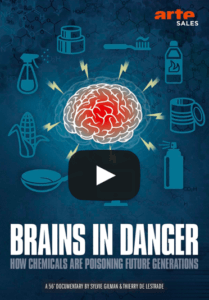October 2017: Brains in danger?
In this edition:
- Brains in Danger?
- Aerial Fire Retardants: It’s Raining Red
- Highly Fluorinated Hush Puppies?
- The Obesity Epidemic: Could Chemicals Contribute?
- Not So Smooth: Toxics in Immersion Blenders
- The Green Science Policy Institute is Hiring
During these challenging times, we have some uplifting news about the increased awareness and decreased use of two of our Six Classes of chemicals of concern. Please check out the dramatic short videos below for some inspiration.
Will Flame Retardants Continue to Harm Future Generations?

A precedent-setting notice from the Consumer Product Safety Commission (CPSC) waspublished last month in the Federal Register warning manufacturers, consumers, and especially pregnant women and children against using the
The largest human chemical experiment is now. (English subtitles can be shown by clicking the settings icon)
entire class of organohalogen flame retardants in children’s products, furniture, mattresses, and electronics cases. This is one of the most precautionary actions ever taken by our government and has the potential to reduce cancer, infertility, and neurological impairments associated with exposure to these flame retardants.
On a related note, San Francisco just passed an ordinance banning the sale of upholstered furniture and children’s products such as high chairs, strollers, and nursing pillows containing any flame retardants. These two huge advances to reduce the use of entire flame retardant classes build on the decade of successful work of our Institute and allies to improve flammability standards and reduce the unnecessary use of these chemicals.
Flame retardants are one of Six Classes of harmful chemicals in everyday products. Please take a minute to watch the powerful Danish video to the right which dramatically shows their adverse impacts.
Denmark Takes Landmark Steps to Reduce Harm from PFASs
Awareness about highly fluorinated chemicals has come a long way since we released the Madrid Statement in 2015.
Patrick Breysse, Director of the CDC’s National Center for Environmental Health, described highly fluorinated chemicals as “one of the most seminal public health challenges for the next decades” at a scientific meeting last week. As reported in Bloomberg News, Breysse said that soon, “we think that hundreds of millions of Americans will be drinking water with levels of these chemicals above levels of concern.”
To help prevent global PFAS pollution, Malene Teller Blume from the Danish Coop, who spoke at our February 2017 meeting at UC Berkeley, is leading a campaign for a national ban in Denmark of highly fluorinated chemicals and harmful bisphenols in food contact materials and other consumer products. After watching the powerful video above, Danes are taking action to ask for chemicals bans in Denmark and across the EU.
To learn the latest about the flame retardants and highly fluorinated chemicals, you can register here for this year’s Flame Retardant Dilemma and Beyond on February 9, 2017 at UC Berkeley.
And if you want to join us in utilizing scientific research towards a healthier world with reduced toxics, check out our jobs page. Please share this link with your friends.
Have a good autumn,
Arlene and the Green Science Policy team
Brains in Danger?

Is exposure to flame retardants and other toxics reducing the intelligence of our population? Check out the trailer to “Brains in Danger: How chemicals are poisoning future generations:” the English version of a new riveting French film, which includes our work on flame retardants. On November 11, 2017 “Demain, Tous Cretins?” will premiere in France, broadcasting the message that we need to reduce the use of toxics to protect our brains and those of future generations.
Aerial Fire Retardants: It’s Raining Red

So far, 2017 is one of the worst fire seasons on record here in Northern California and beyond with staggering devastation from multiple different, simultaneous wildfires. Protecting first-responders, people, and property are a priority.But what kinds of fire retardant chemicals are used to battle these blazes? And how do they impact people and wildlife? Rest assured the aerial flame retardants used to fight wildland fires are not the persistent, bioaccumulative and often toxic chemicals added to furniture foam and plastic. And that alarming bright red color is a dye added to mark areas where retardant has been dropped. Read more in our blog.
Highly Fluorinated Hush Puppies?

Groundwater near a former leather tannery was recently found to have the highest levels of highly fluorinated chemicals ever measured in Michigan drinking water.
Wolverine Worldwide Inc. used 3Ms PFOS-based Scotchguard to waterproof it iconic Hush Puppies shoes on the banks of the Rogue River for decades until PFOS was phased out in 2002 due to its persistence, toxicity, and tendency to bioaccumulate. Recent tests of a household well near the tannery site found 540 times more PFOS and PFOA than the EPAs recommended safe level a staggering 37,800 ppt!
The extremely high contamination is thought to have been caused by leaching of the chemicals from dump sites where Wolverine disposed of manufacturing sludge and leather scraps during the 1960s. The waste materials continue to pollute water more than fifty years after their disposal!
Once again we learn that such persistent chemicals need to be used with extreme caution and only when necessary. For more about this class of long-lasting pollutants, watch our short video here and check out our website here.
The Obesity Epidemic: Could Chemicals Contribute?

About one in three adults are clinically obese in the United States. Another one in three adults are overweight. Altogether, almost 228 million Americans struggle with their weight. Obesity continues to increase worldwide and is associated with diabetes and heart disease.
Although many factors–such as a high calorie diet and a sedentary lifestyle–are contributing to the obesity epidemic, a recent discovery stands out: exposure to environmental toxics such as flame retardants and highly fluorinated chemicals may also play an important role. The programming of obesity may be linked to in utero and/or lifetime exposure to such toxic chemicals. You can read our blog to learn more.
Not So Smooth: Toxics in Immersion Blenders

Immersion blenders conveniently turn food into smoothies, soups, and even baby food. However, they have recently been found to also add an unwanted ingredient: a class of flame retardants called chlorinated paraffins. These chemicals are toxic, persistent, bioaccululative, and listed for elimination in the Stockholm convention. Chlorinated parrafins are also used at plasticizers and lubricans and their total global production is huge– more than 1 million tons per year!
One kind, short-chain chlorinated paraffins, has been detected in human liver, kidneys, fat and breast milk, and is a possible human carcinogen. Swedish scientists recently found that 12 out of 16 immersion blenders tested leaked chlorinated paraffins into food, likely from direct contact between the food and blender components. The researchers estimated that adults in Sweden using an immersion blender once per day could increase their dietary intake in paraffins up to 26 times their normal exposure from food. You can learn more about flame retardants and how to avoid them here.
The Green Science Policy Institute is Hiring
We are hiring a Science and Policy Associate, and also Business Liaison and Communications consultants. If you might like to work with our high-impact, small nonprofit to reduce toxics and protect global health and environment, please visit our jobs page.
Receive Updates By Email
Subscribe to our monthly newsletter and get these updates delivered right to your inbox!